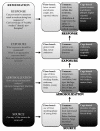An aerobiological perspective of dust in cage-housed and floor-housed poultry operations
- PMID: 19515256
- PMCID: PMC2701955
- DOI: 10.1186/1745-6673-4-13
An aerobiological perspective of dust in cage-housed and floor-housed poultry operations
Abstract
The Canadian poultry production industry contributes nearly $10 billion to the Canadian economy and employs nearly 50,000 workers. However, modern poultry facilities are highly contaminated with airborne dust. Although there are many bioaerosols in the poultry barn environment, endotoxin is typically attributed with the negative respiratory symptoms observed in workers. These adverse respiratory symptoms have a higher prevalence in poultry workers compared to workers from other animal confinement buildings. Workers in cage-housed operations compared to floor-housed facilities report a higher prevalence of some respiratory symptoms. We review the current state of knowledge on airborne dust in poultry barns and respiratory dysfunction in poultry workers while highlighting the areas that need further investigation. Our review focuses on the aerobiological pathway of poultry dust including the source and aerosolization of dust and worker exposure and response. Further understanding of the source and aerosolization of dust in poultry operations will aid in the development of management practices to reduce worker exposure and response.
Figures

References
-
- Chicken Farmers of Canada http://www.chicken.ca/DefaultSite/index.aspx?CategoryID=5&lang=en-CA
-
- Whyte RT. Aerial pollutants and the health of poultry farmers. World's Poultry Science Journal. 1993;49:139–153. doi: 10.1079/WPS19930012. - DOI
LinkOut - more resources
Full Text Sources

